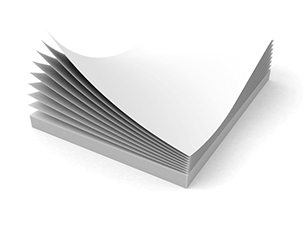
Choosing from the different forms of paper on the market is an important element in achieving high-quality digital printing. You must choose the paper form ideally suited to carrying out the visual and textual contents of your publication or graphic design project, a decision that should be taken with caution and can vary based on the type of product you want to print.
Choosing from the various paper forms available can be difficult when confronted with a vast array of papers, each with a unique set of properties. Each paper type has a weight, a processing type, and a finish that determines its clarity, appearance, weight, thickness, level of opaqueness, feel, and longevity.
In this article, we will look at some of the various weights available on the market, the preferred applications for each, and the most popular paper styles to help you select the paper type that better fits your digital printing needs.
What is paperweight?
The logical meaning of weight, or grammage, is "the heaviness of a piece of paper with a surface region of one square meter"; all in all, it estimates the weight-to-territory proportion of the paper. It is said something grams per square meter (gsm) or basically in grams (g) and is utilized to separate between various assortments of paper available, just as a few different attributes.
Photocopy paper (also recognized as ‘uncoated paper') has a weight ranged from 6 gsm to 90 gsm, whereas paperboard has a mass varying from 150 gsm to 350 gsm. The grammage influences the paper's texture and level of clarity, which would be lower if you select a heavier weight paper.
Weight v.s. Thickness
Distinguishing between the weight of the paper and the thickness/calliper of the sheet is an important aspect. A higher weight usually corresponds to thicker paper, while other factors such as the type of processing, wood fibre content and additives do affect this too:
Type of Processing:
- A processing technique chosen by the papermaker gives paper with same grammage higher density, whereby paper is thinner, or a lower density, whereby paper is thicker.
Wood Fibre Content:
- Made through compacting fibres from trees using chemical processes and mechanical prosseses
- Thickness of paper increases with high wood fibre content
Additives:
- To reduce the use of cellulose and to achieve special visual and tactile effects, papermakers may add certain substances to the pulp.
- An example would be Laguna paper, which is environmentally friendly as it’s made with seaweed from the Venice Lagoon.
Depending on the type of processing and the paper’s composition, it is obvious that two sheets can have different thickness even if they weigh the same.
Why Does Weight Matter?
Depending on what is being printed, be it business cards, advertising displays or flyers, each product has a recommended weight. If the wrong type of paper is used, the end product would not be ideal.
Paper types range from 90-gsm to 380-gsm, and each type serves a different purpose and is most suitable for different types of printing.
90-gsm:
- Uncoated Paper category; natural, wood-free paper and free from any chemical treatments
- Ideal for printing large quantities of text on a light and thin document
- White or ivory colour is usually used
130-gsm:
- Best for reproduction of high-quality colour images, glossy magazines, brochures, posters and folded flyers
- Matt or gloss finish
170-gsm:
- Light paperboard with a pleasant texture and brilliant colour rendering
- Ideal for printing catalogues, presentations, certificates and posters
- Depending on the paper type, coated, environmentally friendly and recycled versions are available in gloss, satin or matt finishes.
350-gsm:
- Semi-rigid paperboard
- Suitable for business cards, book covers and invitation cards
- Excellent strength and durability due to its thickness
380-gsm:
- Cardboard
- Suitable for packaging, rigid book covers and product tags
- Shock and dent proof
At EazyPrintz, we offer all paper types for our printing services and consumers have the choice to choose the paper type best required for their needs. If you’re looking to print something and are unsure of what paper type to go for, do feel free to enquire with us by chatting with us on our website or by dropping us an email at eazyprintz134@yahoo.com.
For affordable and quality printing in Singapore, do check out our social media platforms;